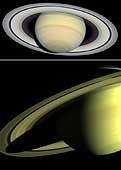|
COMETS EARTH JUPITER KUIPER BELT MARS MERCURY METEORITES NEPTUNE OORT CLOUD PLUTO SATURN SOLAR SYSTEM SPACE SUN URANUS VENUS ORDER PRINTS
PHOTO CATEGORIES SCIENCEVIEWS AMERICAN INDIAN AMPHIBIANS BIRDS BUGS FINE ART FOSSILS THE ISLANDS HISTORICAL PHOTOS MAMMALS OTHER PARKS PLANTS RELIGIOUS REPTILES SCIENCEVIEWS PRINTS
|
Related Document
Download Options
The top image is a view from NASA's Earth-orbiting Hubble Space Telescope taken on March 22, 2004. Camera exposures in four filters (blue, blue-green, green and red) were combined to form the Hubble image and render colors similar to what the eye would see through a telescope focused on Saturn. The subtle pastel colors of ammonia-methane clouds trace a variety of atmospheric dynamics. Saturn displays its familiar banded structure, with haze and clouds at various altitudes. Like Jupiter, all bands are parallel to Saturn's equator. The magnificent rings, at nearly their maximum tilt toward Earth, show subtle hues which indicate the trace chemical differences in their icy composition. To view the top image see PIA05982. The Cassini-Huygens spacecraft returned the bottom image of Saturn on May 16, 2004, when its imaging science subsystem narrow-angle camera was too close to fit the entire planet in its field-of-view. Cassini is still about 20 million kilometers (12.4 million miles) away and only 36 days from reaching Saturn. Cassini has two cameras, a wide angle and narrow angle. This narrow angle image was made using a combination of three filters (red, green, blue) and was taken at a range of 24.3 million kilometers (15.1 million miles). The view is from 13 degrees below the equator. Enceladus, one of Saturnís 31 known moons, appears near the south pole at the bottom of the image. To view the bottom image see PIA05983. The color differences between the Hubble and Cassini images are mainly due to the different sets of filters used. |
